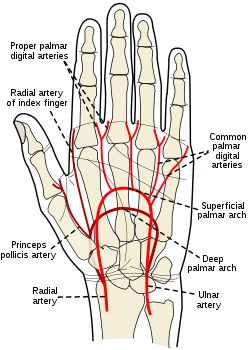
Allen's test
Encyclopedia

Medicine
Medicine is the science and art of healing. It encompasses a variety of health care practices evolved to maintain and restore health by the prevention and treatment of illness....
, Allen's test, also Allen test, is used to test blood supply to the hand. It is performed prior to radial
Radial artery
In human anatomy, the radial artery is the main blood vessel, with oxygenated blood, of the lateral aspect of the forearm.-Course:The radial artery arises from the bifurcation of the brachial artery in the cubital fossa. It runs distally on the anterior part of the forearm...
arterial
Artery
Arteries are blood vessels that carry blood away from the heart. This blood is normally oxygenated, exceptions made for the pulmonary and umbilical arteries....
blood
Blood
Blood is a specialized bodily fluid in animals that delivers necessary substances such as nutrients and oxygen to the cells and transports metabolic waste products away from those same cells....
sampling or cannulation.
It is named for Edgar Van Nuys Allen
Edgar Van Nuys Allen
Edgar Van Nuys Allen was an American doctor who was a native of Cozad, Nebraska. He is remembered for his work done as a Professor of Medicine at the Mayo Clinic in Rochester, Minnesota....
.
Testing for collateral circulation to the hand by evaluating the patency of the radial and ulnar arteries.
The modified Allen Test
1) The hand is elevated and the patient/person is asked to make a fist for about 30 seconds.2) Pressure is applied over the ulnar and the radial arteries so as to occlude both of them.
3) Still elevated, the hand is then opened. It should appear blanched (pallor can be observed at the finger nails).
4) Ulnar pressure is released and the color should return in 7 seconds.
Inference: Ulnar artery supply to the hand is sufficient and it is safe to cannulate/prick the radial
If color does not return or returns after 7–10 seconds, the test is considered positive and the ulnar artery supply to the hand is not sufficient. The radial artery therefore cannot be safely pricked/cannulated.
Anatomical basis
The hand is normally supplied by blood from the ulnar and radial arteries. The arteries undergo anastomosisAnastomosis
An anastomosis is the reconnection of two streams that previously branched out, such as blood vessels or leaf veins. The term is used in medicine, biology, mycology and geology....
in the hand. Thus, if the blood supply from one of the arteries is cut off, the other artery can supply adequate blood to the hand. A minority of people lack this dual blood supply.
Significance
An uncommon complication of radial arterial blood sampling/cannulation is disruption of the artery (obstruction by clot), placing the hand at risk of ischemiaIschemia
In medicine, ischemia is a restriction in blood supply, generally due to factors in the blood vessels, with resultant damage or dysfunction of tissue. It may also be spelled ischaemia or ischæmia...
. Those people who lack the dual supply are at much greater risk of ischemia. The risk can be reduced by performing Allen's test beforehand. People who have a single blood supply in one hand often have a dual supply in the other, allowing the practitioner to take blood from the side with dual supply.
Allen's test is also performed prior to heart bypass surgery. The radial artery is occasionally used as a conduit for bypass surgery, and its patency lasts longer in comparison to the saphenous veins. Prior to heart bypass surgery, Allen's test is performed to assess the suitability of the radial artery to be used as a conduit. A result of less than 3 seconds is considered as good and suitable. A result of between 3-5 seconds is equivocal, whereas the radial artery will not be considered for grafting if the result is longer than 5 seconds.
The utility of the Allen's test is questionable, and no direct correlation with reduced ischemic complications of radial artery cannulation have ever been proven. In 1983, Slogoff and colleagues reviewed 1,782 radial artery cannulations and found that 25% of them resulted in complete radial artery occlusion, without apparent adverse effects. A number of reports have been published in which permanent ischemic sequelae occurred even in the presence of a normal Allen's test. In addition, the results of Allen's tests do not appear to correlate with distal blood flow as demonstrated by fluorescein dye injections
Modifications to the test have been proposed to improve reliability.

